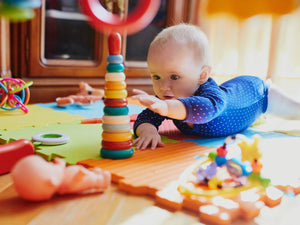Key Points
- Understand the concept of the "motherhood penalty" and how flexible working arrangements can help mitigate its impact on your career
- Take the time to research and select the right childcare provider for both you and your child, considering factors like location, reputation, and staff qualifications
- Prepare your baby for your return to work by transitioning them to bottle feeding, involving your partner in the process and organising feeding equipment and routines ahead of time
Taking time off work to have your baby is one of the most important things you will ever do. Unfortunately for most of us, there comes a point where it’s time to go back to the office. Modern flexible working arrangements are making that easier than ever for parents, but babies aren’t always positively affected by the change.
Going back to work means having to transition to bottle feeding, finding childcare and negotiating new arrangements with your boss. Those things can all seem daunting, but if we break it down into a few individual tasks, it gets much easier to handle the transition. Fortunately, there are many online resources such as our baby feeding guide which covers breast, formula and mixed feeding practices.
The Motherhood Penalty
Stories that appear in news articles show that women suffer a ‘motherhood penalty’ due to taking time off work to have children. Often, they come back to a role that’s changed drastically or no longer there, forcing them out of the workforce. This issue can be corrected if businesses are open to flexible working arrangements.
Currently,workforce participation rates for women are 59.5 per cent in Australia, while male workforce participation rates stand at 71 per cent. There’s often a perception that mothers are not valuable employees since they tend to be the primary caregiver when their children are sick.
But that’s changing thanks to flexible working arrangements. The ability to work remotely, or work from home some of the time, is allowing more parents to balance their family’s needs with their work. Flexible working arrangements aren’t just good news for parents either – they come with serious benefits for businesses:
- Staff turnover is reduced, meaning your business spends less time recruiting and training new employees to replace female employees who resigned
- Employees feel valued and are likely to work harder and be more loyal to the company
- Customer satisfaction is improved because employees are happy, affecting how they interact with clients
- Increased work/life balance leading to healthier staff who take less sick days, and mums can take time off without worrying the boss will be watching
- Access to the best talent in the market
- Reduced costs in hiring office space
- Less chance of employees chucking ‘sickies’ because they feel overworked
- High staff motivation

Make informed decisions about your choice of childcare
The next major hurdle to tackle is childcare. Many new parents receive help from grandparents raising grandchildren and extended family to look after their baby, but many others need to rely on childcare. Choosing the right childcare provider is a serious task. There are lots of options available, but not all childcare is equal, and it’s up to you to find space in a centre that suits your schedule and your baby’s development:
- When choosing childcare centres you need to do your research and ask other parents about their choices. Speak with your partner about what you both see as important for you and your child.
- Be positive about the benefits of childcare. No matter what the reasons, feeling negative about childcare will just make the process a chore.
- Follow your gut feelings if you have them. Many parents just get a “sense” of what’s right from doing a childcare tour. Look at the interaction between the carer and the children and if the children seem well cared for. Gauge how welcome you feel and speak with the director and the carers.
- If your child is old enough, ask them what they’d like. Talk with them about childcare, read books together and answer their questions honestly. Be mindful of your own emotions if you’re feeling anxious. Children are masters of picking up on their parent’s feelings.
- Include Government based sources of information in your research. These need to be non-biased and evidence-based. Check here as well as here for more information.

How to transition to bottle feeding as you return to work
Finally, you need to prepare your baby for your return to work by transitioning to bottle feeding. Making sure your baby is used to bottle feeding before you go back to work is critical. Some babies take longer than others to accept a bottle, especially if they’ve been happily breastfeeding. Allow plenty of time and patience.
Expect some hesitation as your baby adjusts to someone else feeding them. Plan some time with your baby’s caregiver to discuss how you’d like your baby to be fed and what they prefer. Feeding times and positions can all vary between individual babies. Have a couple of practice sessions so they can get used to each other.
Ask the caregiver to try and stick with your baby’s usual feeding times. Routines need to be flexible, but there are real benefits for babies in having a semi-structured routine when it comes to feeding and sleeping patterns.
If you’re doing a combination of breast and bottle feeding, don’t feel you need to stop. You may want to think about expressing your breast milk at work and storing it for bottle feeds. Check here for information on safe storage and feeding of Expressed Breast Milk (EBM). And speak with your manager at work about your break entitlements to express.
Be organised with plenty of bottles, teats, screw caps and formula to cover the number of feeds your baby will need. Consider how you’d like the bottles and feeding equipment rinsed, washed and sterilised when your baby’s at daycare.
Get an insulated feeding bag or esky to keep your baby’s bottles cold. This is especially important if you’ll be transporting EBM or pre-made formula (not advisable).
Work out a labelling system for your baby’s bottles. Childcare centres and in-home day-care often cater for more than one child. Make sure your baby’s feeds and bottles are clearly named to avoid mix-ups.
Get your partner involved in the organising and decision making plans. Different perspectives and sharing tasks is a good way to avoid frustrations.

Five Top Tips for bottle feeding and returning to work
1. Remember, your baby needs breast milk or formula until 12 months of age. Don’t offer straight cow’s milk as their main milk drink before they’ve turned one year of age.
2. From around six months your baby can be offered a sipper cup to practise their drinking skills. So pack a cup and some cooled boiled water for fluid in between their milk bottles.
3. Be confident about your choice of carer for your baby. Doing as much research as you can beforehand and supporting a gradual introduction to childcare will help you adjust.
4. Be organised. Avoid the early morning scramble of packing the nappy bag and getting bottles sorted. Don’t underestimate the value of investing time and energy the night before to help the morning go more smoothly.
5. Expect some glitches as you and your baby adjust to your daily changes. Feeding is a large part of a young child’s life and often reflects other things going on in their life.
About the Author: Jane Barry - Your Health Content Expert
Jane Barry is a registered nurse, midwife, and child health nurse with a passion for combining clinical expertise and writing. She has nearly 30 years of specialist experience in child health nursing and holds a Bachelor's Degree in Applied Science (Nursing). Jane specialises in women’s health, parenting, pregnancy, babies and maternity care, child health, nutrition, feeding, teething, and dental health issues.
An active member of AHPRA, The Australasian Medical Writer’s Association, Health Writer Hub, and the Australian College of Children and Young People’s Nurses, Jane Barry delivers health content with professionalism and clarity.
Our Products
-

01. Guide to a Healthy Pregnancy
$55 -

02. Positive Birthing Course
$55 -

03. Infant Feeding Guide
$55 -

04. Baby Sleep Guide - First 12 Months
$55 -

05. Toddler Parenting Course 1 - 3 Years
$55
-
 When to Start Antenatal Classes?
When to Start Antenatal Classes?
Becoming a parent is an incredible milestone, but it comes with a host of changes that can be daunting, especially for first time parents. Antenatal classes are all about offering expectant parents the education they need to make informed decisions, look after their bodies and care for their newborn babies. While you probably already have a long list of things you need to accomplish during your pregnancy, it’s a good idea to make time to attend antenatal classes.
-
 Development Milestones 4-8 Months
Development Milestones 4-8 Months
As they reach the middle of their first year, you'll start to see bigger leaps in their growth and ability!
In this article, we’re going to discuss your baby’s developmental milestones between 4-8 months, and what you can expect along the way.





 When to Start Antenatal Classes?
When to Start Antenatal Classes?
 Development Milestones 4-8 Months
Development Milestones 4-8 Months








